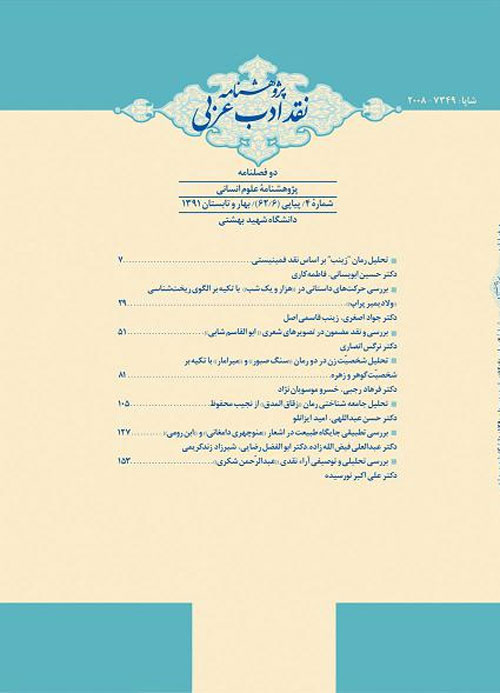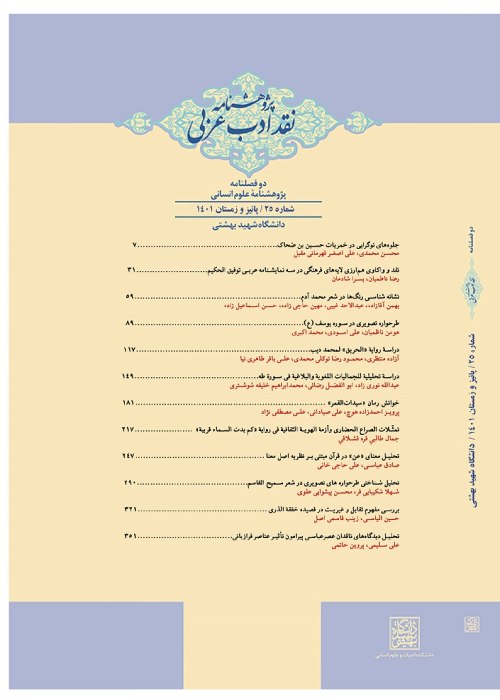فهرست مطالب

پژوهشنامه نقد ادب عربی
سال دوم شماره 4 (بهار و تابستان 1391)
- تاریخ انتشار: 1391/04/14
- تعداد عناوین: 7
-
-
Page 29This study investigates broadly the school of Formalism and the views of its theorists on basis of text analysis, then explain Vladimir Prop’s morphological pattern that is substructure of many patterns of structural, morphological and narrative analysis. Prop’s pattern is based on pragmatics or work of characters and elements of the story is determined by function of every character and compass of his work. After explanation of Prop’s pattern and introducing the movement in the stories and manner of its combination based on his viewpoint survey samples from anecdotes of thousand and one nights, then draw diagrams about text structure story movements. This study demonstrates that Prop’s patterns are applicable on tales of thousand and one night has used different manner of story movements.Keywords: Vladimir prop, one thousand, one nights, story function
-
Page 51Poetic imagery is an inseparable art of poetry; the poet uses poetic imagery to transfer his themes in an expressible and tangible form to its readers. This way, he clarifies his feelings and emotions to the readers. The study of poetic imagery indicates the ability of the poet in creating new concepts, producing spiritual and abstract themes in new forms, and giving life to inanimate objects. The more harmonious, stronger, and expressive the poetic imageries are the more coherent are the poems. More than any other literary schools, the Romantic poets employ poetic imagery. This can be traced in Shabi's works, who represents the Arabic Romantic School. Critics study the poetic imageries from the perspectives of structure and theme. However, the present article starts by providing an introductory discussion of the concept of imagery along with its features in contemporary Arabic poetry. This is followed by a thematic study of poetic imageries in Shabi's poems. This way, the poet's perspective in representing his themes becomes comprehensible and would show how the poet has succeeded in expressing concepts and feelings to the addressee. Shabi's poems refer to themes of death, love, sorrow, people, society and so forth. This could be seen clearly in the themes employed in poetic imageries which is in accord with the School he represents. On the other hand, a point to consider in relation to the poetic imageries used in Shabi's poems signify that nature and its adapted elements play an important part in expressing most of the imageries.Keywords: Arabic Poetry, Contemporary poetry, Poetic imagery, Abul Ghasem Shabi, Theme
-
Page 81Woman issues as one of the most important humanity problems in contemporary literature, has special place. In this case, Sadegh chobak and Najib Mahfoz who are two prominent writers in Persian and Arabic literature reflected their ideas meticulously.Gohar and Zohre, representative of Iranian and Egyptian woman, are two characters that all writers try to show them as the leader and sample of their society. The outlook toward these two characters represent people who are deprived of their own rights in society, and are forced to tolerate the conditions that some silly people exert on them. They do not have any chance and opportunity to defend them or state their ideas. We can observe these kind of failure and inability in these novels both in the government and structure of them,and show a new view on these two domains for the readers.Keywords: woman, Gohar, Zohre, Chobak, Mahfoz, deprivation, society
-
Page 105Literary work is mirror of social life. "Novel" is the main form of contemporary world, special for bourgeoisie society, and it's hero is a normal person and ususally is from the middle class. Novel could reflect a real problem of community more than any other literary form and Naguib Mahfouz as a famouse novelist, wrote social novel has tried to express social realities of Egyptian society. The "Ziqaq Almidaq" novel is the product the right period. The alley is symbol of the traditional Egyptian community with character's that are symbol of one's social class. In this work the tradition is opposite of modernism and the author outlines the consequences of abandoning the tradition and deals to modernism. Corruption of womens, economic and cultural poverty, and political ignorance are the major themes that we can see itin this work.Keywords: Naguib Mahfouz, Sociological critique, Ziqaq Al Midaq
-
A comparative survey of the altitude of nature in " Manouchehrie Damghani" and " Ebne Roumi" s poemsPage 127Nature has always been an essential and indispensable element and one of the oldest cradles in regard to verse and literature discussions. Also, it has played a significant role in the stimulation of human feelings. Because of this feature, it has been noticed by many poets and literary men. It rarely occurs that a poem is beautiful but there is not a trace of Nature in it. By analyzing these two great poem’s bureaus, a lot of similarities as well as differences in their manner of describing the Nature have been found. This paper aims at analyzing the described Nature in the poems of these two well-known poets by inspiring from the Nature. “Manouchehriye Damghani”, one of the most famous poets of Persia, is very adept in his description of Nature and can represent the Nature in an expressive and tangible manner. In the survey of Arabic literature we come across a renowned poem,”Ebne Roumi”, who has been successful in granting the Nature a new spirit which expresses the internal secret for the readers. When reading Manouchehri’s poems,always a special vivacity which belongs to his spirit is conveyed to the readers. But, because of many difficulties that Ebne Roumi had to tackle in his life, his poems transfer a sense of despair and melancholy to the learners.Keywords: Nature, images, altitude, Roudaki, Ebne Roumi
-
Page 153Abdel Rahman Shokry was a sensitive and astute poetry and he was very impressed by the events that were happening around her. Researchers who have examined the shokry’s poems believe that the evidence of his poetry have had several signs of pessimism, which made them to contribute him as pessimistic. However, there has beenfound some poetry that represents his optimism. Since Pessimism of shokry was not totally dark and there would be glimmer of hope. Hope that will reinforce the will and encourage people to move forward. We see the opening doors of hope and desire in many parts of the poems. He believes that the human has got a power that enables him to turns pessimism to optimism, so he was definitely optimistic in several periods of his poetic and personal life and evokes beautiful life. He doesn’t look at life pessimistically, but also looks realistically. While this realistic sight is pessimistic. In this article, we are going to investigate the validity of shokry’s pessimism critics with their reasons, and making the views of shokry unveiled. The subject has not been investigated in any other previous articles or books. We believe that shokry was not a pessimistic poet, but also the smell of optimism can be felt by fair critics.Keywords: Abdel Rahman Shokry, optimism, pessimism, Arabic contem


